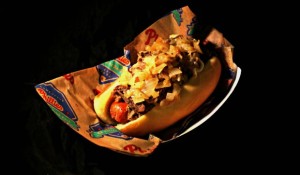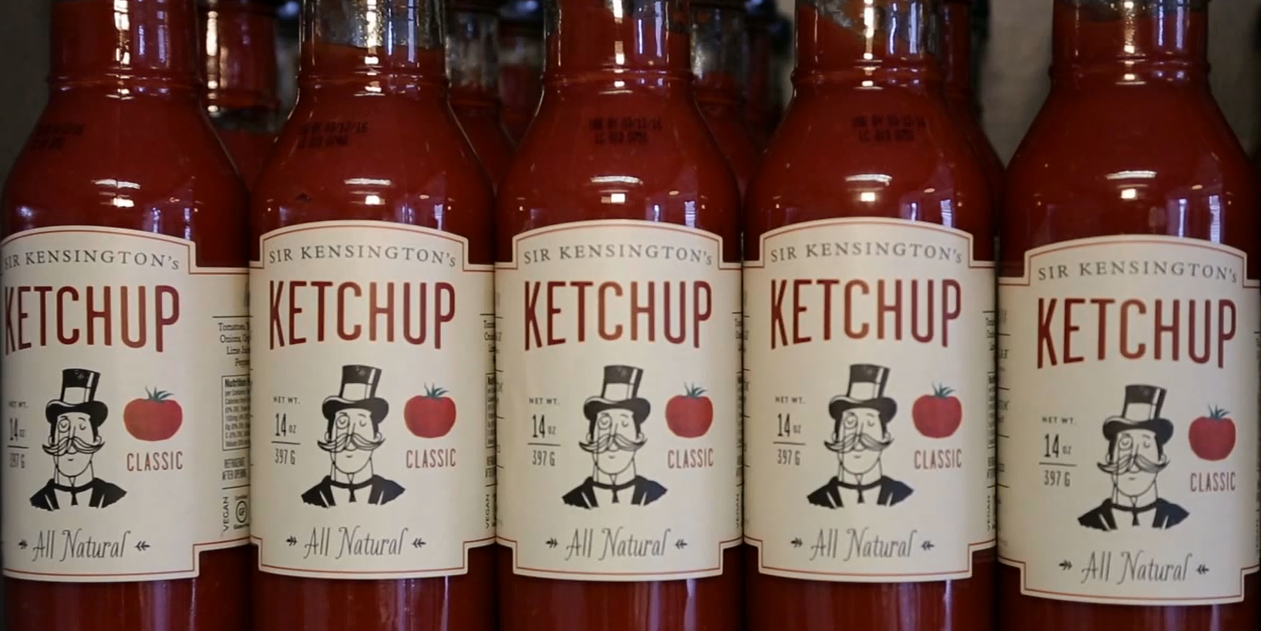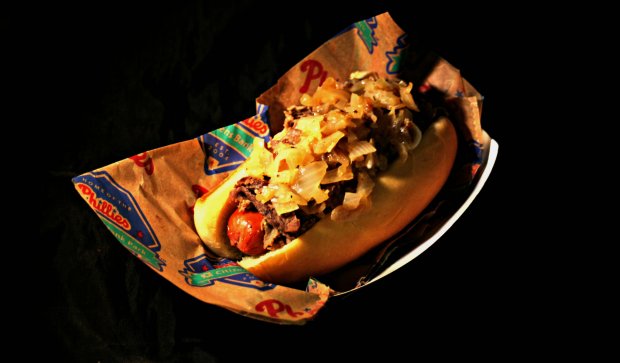 In the old days, your mother would probably scold you for making such horrible noises at suppertime: Slurping your soup was considered poor table manners in polite American society, an egregious faux pas memorably (and quite audibly) sent up in the 1985 crime-comedy Clue. Nowadays, amid the growing influence of Asian food and Asian customs in this country, your dining companions might hardly wince at these loud sucking sounds. On the contrary, they might just join in the ruckus. In some of today’s more fashionable locales, slurping is not merely accepted. It’s downright proper. Continue reading “It’s Cool To Slurp Now”
In the old days, your mother would probably scold you for making such horrible noises at suppertime: Slurping your soup was considered poor table manners in polite American society, an egregious faux pas memorably (and quite audibly) sent up in the 1985 crime-comedy Clue. Nowadays, amid the growing influence of Asian food and Asian customs in this country, your dining companions might hardly wince at these loud sucking sounds. On the contrary, they might just join in the ruckus. In some of today’s more fashionable locales, slurping is not merely accepted. It’s downright proper. Continue reading “It’s Cool To Slurp Now”
Hip To Be Square: Grandma Pizza Feels Right At Home In New York
 Who knew that “grandma” could be so in fashion? I’m referring, of course, to the grandma pizza. Or grandma pie, as it appears on the menu at GG’s in New York City’s East Village. If, that is, you even bother to look. “It’s the one thing that people order as soon as they sit down, and they don’t even look at the menu — they order it before they order drinks,” says executive chef Bobby Hellen.
Who knew that “grandma” could be so in fashion? I’m referring, of course, to the grandma pizza. Or grandma pie, as it appears on the menu at GG’s in New York City’s East Village. If, that is, you even bother to look. “It’s the one thing that people order as soon as they sit down, and they don’t even look at the menu — they order it before they order drinks,” says executive chef Bobby Hellen.
Indeed, Hellen’s signature six-slice pie, liberally dotted with little pepperonis and flagged with fresh basil, has become quite the sensation since the restaurant opened last fall. The Village Voice raved about the sauce, colorfully describing it as “more herb-stocked than a Colorado dispensary.” (Hellen grows many of the ingredients in the restaurant’s garden out back.) Eater, meanwhile, has gone into exhaustive detail in outlining the chef’s intensive pizza-making process.
But while Hellen’s grandma pie is perhaps the most prominent of its kind at the moment, it is far from the only example of this increasingly popular, yet relatively new style of pizza. From old-school joints like J & V Pizzeria in Bensonhurst to newer spots like Best Pizza in Williamsburg, grandma is flourishing on menus across the city — and beyond. Once considered a strictly New York phenomenon, the style is beginning to transcend its regional trappings. Writing in Pizza Today, California-based pizza maker Tony Gemignani, who serves his own version of the grandma at Slice House in Rohnert Park, recently recounted his first encounter with a grandma pizza in Italy, at a place run by a Staten Island ex-pat who wanted to bring this new style to the old world.
What is a grandma pie? Continue reading “Hip To Be Square: Grandma Pizza Feels Right At Home In New York”
The New ‘Cue York: How BBQ Became NYC’s Most Addictive Smoking Habit
 Since the opening of Blue Smoke in 2002, New York City has made tremendous strides toward shedding its historical reputation as a barbecue backwater — more than 30 brick-and-mortar restaurants (and counting) are currently dishing up one style of barbecue or another across the five boroughs. We’re talking about authentic barbecue, mind you, the kind that’s slow-cooked over real smoldering wood. Not grilled or baked in some conventional gas oven, with possibly a dash of the pitmaster poseur’s notorious cheat: liquid smoke. But, only recently has the quality of New York ‘cue risen to such a level that it merits even a mention in the national conversation. Read my full article at Food Republic or Medium.
Since the opening of Blue Smoke in 2002, New York City has made tremendous strides toward shedding its historical reputation as a barbecue backwater — more than 30 brick-and-mortar restaurants (and counting) are currently dishing up one style of barbecue or another across the five boroughs. We’re talking about authentic barbecue, mind you, the kind that’s slow-cooked over real smoldering wood. Not grilled or baked in some conventional gas oven, with possibly a dash of the pitmaster poseur’s notorious cheat: liquid smoke. But, only recently has the quality of New York ‘cue risen to such a level that it merits even a mention in the national conversation. Read my full article at Food Republic or Medium.
Sir Kensington’s Wins This Round, But The ‘Ketchup Wars’ Are Far From Over
 Let’s be upfront: I’m a Heinz devotee, and I’m not shy about it. When I come across menus that advertise some artisanal house-made ketchup instead, I wonder why the chef doesn’t do something more worthwhile with his time, like build a better french fry. As far as I’m concerned, ketchup was perfected long ago, and you know it when you see the number 57 on the bottle. Heinz’s overwhelmingly popular formula, as the New Yorker astutely observed back in 2004, hits all five fundamental tastes on the human palate: salty, sweet, sour, bitter and umami. You can’t really do much better than that. Complain all you want about high-fructose corn syrup — Heinz has an answer for that, too. Lately, I’ve noticed a few restaurants offering a different kind of ketchup, one with some stuffy-looking mustachioed stranger wearing a monocle and top hat on the label, called Sir Kensington’s. The sheer presence of this dubious parvenu is often enough to make me change my side order from fries to salad. Read my full article at Food Republic.
Let’s be upfront: I’m a Heinz devotee, and I’m not shy about it. When I come across menus that advertise some artisanal house-made ketchup instead, I wonder why the chef doesn’t do something more worthwhile with his time, like build a better french fry. As far as I’m concerned, ketchup was perfected long ago, and you know it when you see the number 57 on the bottle. Heinz’s overwhelmingly popular formula, as the New Yorker astutely observed back in 2004, hits all five fundamental tastes on the human palate: salty, sweet, sour, bitter and umami. You can’t really do much better than that. Complain all you want about high-fructose corn syrup — Heinz has an answer for that, too. Lately, I’ve noticed a few restaurants offering a different kind of ketchup, one with some stuffy-looking mustachioed stranger wearing a monocle and top hat on the label, called Sir Kensington’s. The sheer presence of this dubious parvenu is often enough to make me change my side order from fries to salad. Read my full article at Food Republic.
Montreal Vs. New York: A Matchup That Transcends Hockey. Bagels Involved.
 In the lead-up to Thursday’s big game, Food Republic spoke with NHL forward (and doughnut mogul) Jeff Halpern and restaurateur (and die-hard Habs fan) Joel Tietolman to get a better sense of how both food scenes match-up, regardless of the outcome on the ice. Read the full article here.
In the lead-up to Thursday’s big game, Food Republic spoke with NHL forward (and doughnut mogul) Jeff Halpern and restaurateur (and die-hard Habs fan) Joel Tietolman to get a better sense of how both food scenes match-up, regardless of the outcome on the ice. Read the full article here.
Remember the Old Tavern On The Green? How Ornate! How Indifferent!
 Long-shuttered Central Park restaurant Tavern On The Green has finally reopened, bringing to mind my last meal there back in 2009, which I wrote about for the Observer:
Long-shuttered Central Park restaurant Tavern On The Green has finally reopened, bringing to mind my last meal there back in 2009, which I wrote about for the Observer:
“It reminds me of Mrs. Havisham in Great Expectations, the grande dame who’s seen better days,” my perceptive spouse said, noting the fraying pink tablecloth covering our sloppily bussed table, which was strewn with stray bread crumbs and specs of black pepper. “It seems a little worn around the edges.”
The service, meanwhile, seemed remarkably indifferent. When we complained about the large triangular gap in window shading, which cast a blinding beam of afternoon light directly at our table, and politely suggested that something be done about it, our crusty career waiter, dressed in a black suit and pink-and-green-striped bow tie, barely shrugged: “I’ve been advocating for that for 10 years now.”
Here’s to hoping they’ve finally gotten that fixed. Continue reading “Remember the Old Tavern On The Green? How Ornate! How Indifferent!”
Meet George Marsh, the Baltimore Butcher Who Rejects the Word ‘Charcuterie’
 In a fancier setting, sliced meats like these — coppa, mortadella, nduja — would merit a fancier menu heading. Amid the candle-lit smug of your average wine-centric corner bistro, this sort of stuff is commonly called “charcuterie” and it typically arrives served on a wood plank with pickles, olives and maybe, if you’re truly lucky, a tiny shrimp fork to stab yourself with. Here at Baltimore’s Parts & Labor, a former tire depot turned butcher shop and beer hall with a big wood-burning hearth, the language is a little different. You find a lot of similar things: salami, country ham, corned beef tongue. On the menu, though, you’ll find them listed under a quainter title: “From the Salt House.” That’s because the bearded guy with the band saw behind the butcher case isn’t especially fond of the usual butcher-board terminology. “To call it ‘charcuterie’ doesn’t make a whole lot of sense to me,” says P&L’s executive chef and head butcher George Marsh. Continue reading “Meet George Marsh, the Baltimore Butcher Who Rejects the Word ‘Charcuterie’”
In a fancier setting, sliced meats like these — coppa, mortadella, nduja — would merit a fancier menu heading. Amid the candle-lit smug of your average wine-centric corner bistro, this sort of stuff is commonly called “charcuterie” and it typically arrives served on a wood plank with pickles, olives and maybe, if you’re truly lucky, a tiny shrimp fork to stab yourself with. Here at Baltimore’s Parts & Labor, a former tire depot turned butcher shop and beer hall with a big wood-burning hearth, the language is a little different. You find a lot of similar things: salami, country ham, corned beef tongue. On the menu, though, you’ll find them listed under a quainter title: “From the Salt House.” That’s because the bearded guy with the band saw behind the butcher case isn’t especially fond of the usual butcher-board terminology. “To call it ‘charcuterie’ doesn’t make a whole lot of sense to me,” says P&L’s executive chef and head butcher George Marsh. Continue reading “Meet George Marsh, the Baltimore Butcher Who Rejects the Word ‘Charcuterie’”
Peanuts to Artisanal Peanut Brittle: A Modern History of Baseball Stadium Food
 Mike Isabella is probably not the first rookie in the major leagues to take a swing at chicken parm stardom. But the version that he’s bringing to Nationals Park in Washington, D.C. this spring is a significant upgrade on the typical red-sauced cutlets on a roll, he says. Maybe not a whole different animal, per se, though he does claim to use the whole animal. “The difference is, we use the whole chicken,” says Isabella, the Top Chef alum and operator of three D.C. restaurants. Beyond the usual cutlets, the TV chef — who famously invented pepperoni sauce — will also be braising chicken legs to make a ragu, he notes. That goes on the bread first, then the cutlet, then the tomato sauce, then the fresh mozzarella, and then — for a little added contemporary flair —some Thai basil. “It’s big, it’s serious, but it’s the whole chicken,” Isabella says proudly. “There’s not too many chicken parms where you get the chicken ragu on the bun.” If the idea of simmering animal parts doesn’t strike you as the most appetizing option for fourth-inning snacking, no problem. Isabella’s new G Sandwich Stand, a sporty spinoff of his existing fast-casual spot, also offers a vegetarian option: crispy roasted cauliflower topped with romesco, charred scallions and shishito peppers on a sesame roll. “We roast it until it’s a little bit over al dente,” Isabella says of the cauliflower, which is then tossed in a paprika and lemon vinaigrette for extra acid and smoke. It’s a far cry from hotdogs, peanuts and Cracker Jack. Sustainability and farm-to-table ethics at the concession stand? Is this Major League Baseball or a Portlandia sketch? Continue reading “Peanuts to Artisanal Peanut Brittle: A Modern History of Baseball Stadium Food”
Mike Isabella is probably not the first rookie in the major leagues to take a swing at chicken parm stardom. But the version that he’s bringing to Nationals Park in Washington, D.C. this spring is a significant upgrade on the typical red-sauced cutlets on a roll, he says. Maybe not a whole different animal, per se, though he does claim to use the whole animal. “The difference is, we use the whole chicken,” says Isabella, the Top Chef alum and operator of three D.C. restaurants. Beyond the usual cutlets, the TV chef — who famously invented pepperoni sauce — will also be braising chicken legs to make a ragu, he notes. That goes on the bread first, then the cutlet, then the tomato sauce, then the fresh mozzarella, and then — for a little added contemporary flair —some Thai basil. “It’s big, it’s serious, but it’s the whole chicken,” Isabella says proudly. “There’s not too many chicken parms where you get the chicken ragu on the bun.” If the idea of simmering animal parts doesn’t strike you as the most appetizing option for fourth-inning snacking, no problem. Isabella’s new G Sandwich Stand, a sporty spinoff of his existing fast-casual spot, also offers a vegetarian option: crispy roasted cauliflower topped with romesco, charred scallions and shishito peppers on a sesame roll. “We roast it until it’s a little bit over al dente,” Isabella says of the cauliflower, which is then tossed in a paprika and lemon vinaigrette for extra acid and smoke. It’s a far cry from hotdogs, peanuts and Cracker Jack. Sustainability and farm-to-table ethics at the concession stand? Is this Major League Baseball or a Portlandia sketch? Continue reading “Peanuts to Artisanal Peanut Brittle: A Modern History of Baseball Stadium Food”
Meet Justin Severino, Pittsburgh’s Sultan of Spiked Salami
 Sherry-spiked saucisson, Fernet Branca–spiked salami, Cynar-spiked swordfish: with so much booze in the food, it’s hard to imagine that Cure, chef Justin Severino’s quasi-quaint charcuterie spot in Pittsburgh, started out just two years ago as a bone-dry BYOB. “We had almost no money,” Severino says of his fashionably rustic-looking restaurant’s humble roots. No, Cure’s chef-owner didn’t grow up in a barn. He merely reconstructed one inside an urban retail setting, with interior walls of reclaimed wood and meat hooks for coat hangers. “We opened minimally,” he says. Surviving for so long on food sales alone is a big source of pride for Severino: “We had a year and a half to gain success without selling liquor, and restaurants don’t typically do that that easily.” Nowadays, however, the hooch is in high supply, both at the bar and in the kitchen. And the chef himself couldn’t be happier about having a properly stocked shop from which to sip and to experiment. “I like to drink adult beverages and I tend to be a bit of a snob about what those things are,” he says. Continue reading “Meet Justin Severino, Pittsburgh’s Sultan of Spiked Salami”
Sherry-spiked saucisson, Fernet Branca–spiked salami, Cynar-spiked swordfish: with so much booze in the food, it’s hard to imagine that Cure, chef Justin Severino’s quasi-quaint charcuterie spot in Pittsburgh, started out just two years ago as a bone-dry BYOB. “We had almost no money,” Severino says of his fashionably rustic-looking restaurant’s humble roots. No, Cure’s chef-owner didn’t grow up in a barn. He merely reconstructed one inside an urban retail setting, with interior walls of reclaimed wood and meat hooks for coat hangers. “We opened minimally,” he says. Surviving for so long on food sales alone is a big source of pride for Severino: “We had a year and a half to gain success without selling liquor, and restaurants don’t typically do that that easily.” Nowadays, however, the hooch is in high supply, both at the bar and in the kitchen. And the chef himself couldn’t be happier about having a properly stocked shop from which to sip and to experiment. “I like to drink adult beverages and I tend to be a bit of a snob about what those things are,” he says. Continue reading “Meet Justin Severino, Pittsburgh’s Sultan of Spiked Salami”
Hot Doug’s Mastermind Doug Sohn On The Only Sausage He Couldn’t Sell
 Doug Sohn, owner of Hot Doug’s, Chicago’s most glorified hot dog stand, has sold all sorts of sausages over the years, from the classic Windy City–style Vienna beef dog to the “Tuben,” his tubular take on a traditional Rueben sandwich. Sohn’s often obscurely titled franks (“The Shirley Hardman,” anyone?) span virtually every type of meat in your butcher’s repertoire and probably beyond, including an ever-revolving “Game of the Week” special, which spotlights a different wild animal: alligator, crawfish, pheasant, snake — you name it, he’s probably stuck it in a bun, added some unusual toppings for good measure and sold it. Only one weird wiener has ever turned out to be a total dud, according to Sohn: the andouillette, which he explains is the French word for, basically, “intestines stuffed with more intestines.” Continue reading “Hot Doug’s Mastermind Doug Sohn On The Only Sausage He Couldn’t Sell”
Doug Sohn, owner of Hot Doug’s, Chicago’s most glorified hot dog stand, has sold all sorts of sausages over the years, from the classic Windy City–style Vienna beef dog to the “Tuben,” his tubular take on a traditional Rueben sandwich. Sohn’s often obscurely titled franks (“The Shirley Hardman,” anyone?) span virtually every type of meat in your butcher’s repertoire and probably beyond, including an ever-revolving “Game of the Week” special, which spotlights a different wild animal: alligator, crawfish, pheasant, snake — you name it, he’s probably stuck it in a bun, added some unusual toppings for good measure and sold it. Only one weird wiener has ever turned out to be a total dud, according to Sohn: the andouillette, which he explains is the French word for, basically, “intestines stuffed with more intestines.” Continue reading “Hot Doug’s Mastermind Doug Sohn On The Only Sausage He Couldn’t Sell”









